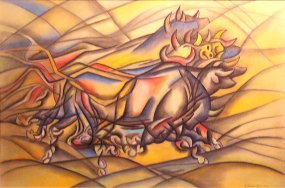Estuardo Maldonado facts for kids
Estuardo Maldonado, born in 1928, is a famous artist from Ecuador. He is known for his sculptures and paintings. His art style is inspired by something called Constructivism. Maldonado was part of an art group called VAN, which stands for Vanguardia Artística Nacional. This group included other important artists like Enrique Tábara, Aníbal Villacís, and Luis Molinari. Maldonado's art has been shown in many exhibitions around the world.
Contents
Early Life and Art Journey
Estuardo Maldonado was born in Píntag, a place near Quito, Ecuador. When he was young, he left home to learn from nature. Nature and themes from Indigenous cultures have always been a big part of his artwork.
He studied art at the School of Fine Arts in Guayaquil. By 1953, he was teaching art himself at the American School of Guayaquil. In 1955, Maldonado traveled along the coast of Ecuador. He painted the people and beautiful landscapes he saw there.
In 1955, Maldonado had his first art shows in Guayaquil, Portoviejo, and Esmeraldas. The next year, in 1956, he was invited to show his art at the House of Ecuadorian Culture. This made him the first Ecuadorian artist to show sculptures in Quito and Guayaquil.
In 1957, Maldonado received a scholarship to travel to Europe. He visited France, Germany, Switzerland, and the Netherlands. He then settled in Rome, Italy, where he continued his art studies.
Maldonado's Art Style
Maldonado's art often shows abstract forms inspired by nature. You can also see hints of his family's history in some of his works. These pieces are based on ancient pre-Columbian art from his native Andean region. He is also very interested in how the Universe is always changing and growing. This mix of old and new ideas makes him an important artist in the Latin American Constructivist art movement.
What is Constructivism?
Vladimir Tatlin started the Constructivist art movement in Russia in 1913. This style was influenced by Futurism and Cubism. Constructivism uses abstract shapes and geometric forms. It is also connected to ideas about architecture and building.
The Constructivist movement came to Latin America through artists like Joaquín Torres García and Manuel Rendón. Joaquín Torres García created a new style called Constructive Universalism. He lived in Europe for over 40 years, then returned to his home country, Uruguay. He brought new art ideas with him. Constructive Universalism combines ancient Pre-Columbian art with the geometric shapes of European Constructivism.
Maldonado's art is famous worldwide because he successfully combines nature with new ideas. He also connects his art to his Andean roots.
Awards and Recognition
In 2009, Estuardo Maldonado received the Premio Eugenio Espejo. This is the highest award for art, literature, and culture in Ecuador. The President of Ecuador presents this important award.
Museums and Exhibitions
Estuardo Maldonado's art has been shown in many places around the world. Here are some of the museums and exhibitions where his work has been featured:
- 1956 - House of Ecuadorian Culture, Guayaquil, Ecuador
- 1964 - Biennial of Venice, Venice, Italy
- 1974 - Center for the International Studies of Constructivist Art, Bonn, Germany
- 1974 - Marcon IV Gallery, Rome, Italy
- 1977 - Abstract Currents in Ecuadorian Art: Paintings by: Gilbert, Rendón, Tábara, Villacís, Molinari and Maldonado. Center for Inter-American Relations, New York, New York, U.S.
- 1985 - First Latin American Symposium of Sculpture of Santo Domingo, Dominican Republic
- 1985 - Art Museum of the Americas, Organization of American States (OAS), Washington, D.C.
- 1986 - Ecuadorian Embassy, Port-au-Prince, Haiti
- 1987 - I Biennial International Painting of River Basin, River Basin, Ecuador
- 1987 - Museum of Contemporary Hispanic Art (MoCHA), New York
- 1988 - XX Biennial of São Paulo, São Paulo, Brazil
- 1991 - Masters of Latin America, Nagoya, Japan
- 1994 - Gallery of Nadar Art, Dominican Republic
- 1998 - Museum of Italian Art, Lima, Peru
- 2000 - Pontifica Catholic University of Ecuador
- 2000 - Museum of Modern Art, Santiago, Chile
- 2000 - Exhibition, Perth, Western Australia
- 2001 - Exposición Centro Cultural Metropolitano de Quito, Ecuador.
- 2002 - Antología"1945-2002", Pontificia Universidad Católica de Ecuador.
- 2002 - Sala Municipal de Exposiciones de Valencia. L'Almudí.Valencia, Spain
- 2003 - Museo Luis Gonzalez Robles Alcalá de Henares. Madrid, Spain
- 2004 - Banco Central del Ecuador. Quito, Ecuador.
- 2004 - Galería Arte Jorge Ontiveros. Madrid, Spain
- 2004 - Sala Ayuntamiento L'Olleria. ValenciaSpain
- 2005 - Exposición en Chicago. Galería Aldo Castillo.
- 2005 - Fundación Jaume II el Just. Real Monasterio Santa Maria Valldigna. Generalitat Valenciana (Simat de Valldigna).
- 2005 - Sala Exposiciones Ayuntamiento de Elche. Alicante. España
- 2005 - Aldo Castillo Gallery, Chicago USA
- 2006 - The Katzen Art Center at American University, Washington, D.C., USA
- 2006 - Sala Autoral, Estuardo Maldonado, Museo Antropologico y de Arte Contemporaneo (MAAC), Guayaquil, Ecuador.
- 2007 - Galeria de Arte "CosmoArte Siglo XXV". Alicante, Spain
- 2008 - Ministry of Foreign Trade and Integration - Ecuadorian Embassy in Germany, Berlin, Germany.
- 2008 - ArtMadrid. Madrid. España
- 2008 - Sala de Exposiciones Parque de atracciones "Terra Mitica" . Benidorm. Alicante, Spain
- 2008 - Expo Zaragoza 2008. Pabellón de las Artes de Telefónica. Zaragoza, Spain
See also
 In Spanish: Estuardo Maldonado para niños
In Spanish: Estuardo Maldonado para niños


